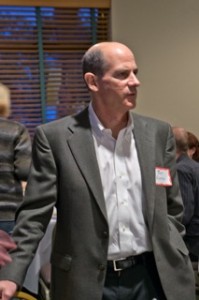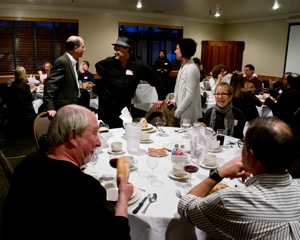The Topic of Aging
By Suzanne Birrell
“And so, from hour to hour, we ripe and ripe,
And then, from hour to hour, we rot and rot.”
Shakespeare’s “As You Like It”; Act II Scene 7
Does anyone really know what time is? Or does?
Does the passing of time have to result in a body getting old?
Why is it that a body, which apparently miraculously rapidly grows from a single stem cell to a complex, fully grown, functioning, thinking and reasoning (two different things), self repairing entity with a frequent cellular turnover, can’t seem to keep itself going indefinitely?
But since the fact that the body doesn’t simply replace cells indefinitely, then the big question we really want to know (we who are feeling the aches and pains of age in our bones and muscles) is:
Can we reset the Aging Clock?
These questions and more were the topic of the latest NCSWA Spring lecture/dinner on Wednesday March 21, 2012 at The Basque Cultural Center in San Francisco. Featured as the quest lecturer for the Northern California Science Writers Associations quarterly dinner was:
Tom Rando, MD, PhD, Director of the Glenn Laboratories at Stanford, (One of four such centers funded by the Paul. F. Glenn Foundation)
Professor Rando enthusiastically spoke about his cutting-edge research. Apparently research is very exciting when you find out things you didn’t expect to find out, and we were told frequently that Professor Rando and his team did not expect results they have so far observed.
Rando’s team started with the goal of defining bio-markers which indicate the age of a cell: or in other words: is it possible to measure aging on the cellular level? They started by studying aging and longevity, which are two different issues.
The average lifespan 15,000 years ago in Europe was 25 years. Then in Rome 11,000 years ago it was up to 35 years. The average life span in the USA in 1900 was 50, but by 1970 it was up to 70 years old, and in 2010 the average was up to 80 years. Up to the turn of the century, keeping babies alive has been the primary factor in the dramatic increase of the “average life-span.” However the number of centenarians is increasing all over the world with many who are in the 110-120 year age bracket.
Though the good news is, as photographs show, we are reaching older age while looking better, the question is why? Rando’s team asked the questions “What happens as we get old?” and “Can aging be slowed?”
Research has demonstrated that 55% fewer calories can contribute to almost a 50% greater lifespan! And, results can be enjoined at a later age (meaning that you can start your mean and lean diet after you are older and may enjoy the benefits of the 50% increase in life span!)
However, before you start on your starvation diet, you should know that is not only fewer calories BUT fewer calories with adequate nutrition. A problem with this modicum of knowledge is, as Professor Rando pointed out, we really don’t know what adequate nutrition is, and nutritional deficiencies can result in early death.
Since the results of caloric adjustments have demonstrated that aging can be slowed, Rando’s team moved on to attempt to identify what exactly happens to a single cell as the body ages. The moot point to boot was that a single stem cell grows to a beautiful smooth skinned child. The skin cells replace themselves with new skin cells every few days, but a sure sign of age is the appearance of skin. What causes this epigenetic (resulting from external rather than genetic influences) change? Committed skin stem cells give rise to new skin cells. The stem cells are all there, but the tissues do not regenerate as well which means that the older body is slower to heal from an injury.
Dolly the sheep was cloned from a single stem cell of a mature animal. In that case the age of the cell was started again at zero and then differentiated. Professor Rando was curious as to why new skin shows epigenetic changes as a body ages when a whole new body can be cloned from a single stem cell of the same aged body.
Rando’s team found that as body gets older, the skin cells show a reduction in the amount of a protein within the cell. When they parabioticly conjoined a young mouse to its genetically identical older twin, the scientist were astonished to observe that the amount of protein in the older mouse’s skin cells increased while the younger mouse’s protein count decreased. In effect they were able to reset the aging clock of the older mouse. When they separated the mice, however, the protein levels returned to their initial state. The team also simply gave the blood of a younger mouse to that of the older mouse and saw minute changes which did not last long at all.
Though Rando’s investigations suggest we mortals might someday be able to rejuvenate our aging bodies with the proteins abundant in young blood, Rando and his team are hoping this knowledge leads to the ability to help older people heal faster.
It was a fascinating lecture. The Q & A afterwards was particularly engaging.
I simply listened, but I do, upon retrospect, have a few questions:
1. Are vampires really all about keeping those youthful protein levels high?
2. If we gave our blood in abundance when we were young, could we get it back when we are old thereby keeping our regenerating proteins at a high level?
3. Do I really want to live to be as old as Adam (930 years)? That’s an awful lot of taxes.
I do invite you again to check out the NCSWA website: http://www.ncswa.org/index.htmlthe
Their next lecture should be in June and I promise it will be interesting with great food and scintillating conversation. The NSCSWA also has field trips and workshops.
———————————————————————————————-
You can reach Suzanne Birrell at Suzanne@thisoldhippy.com.


